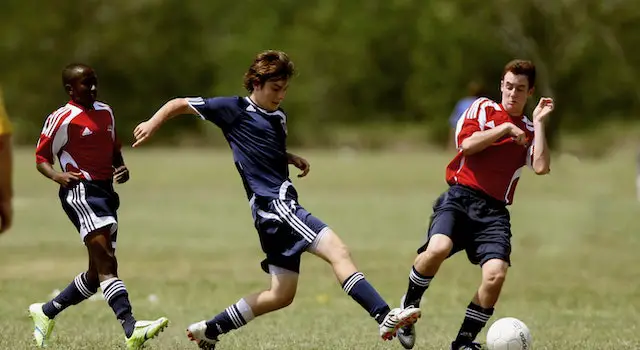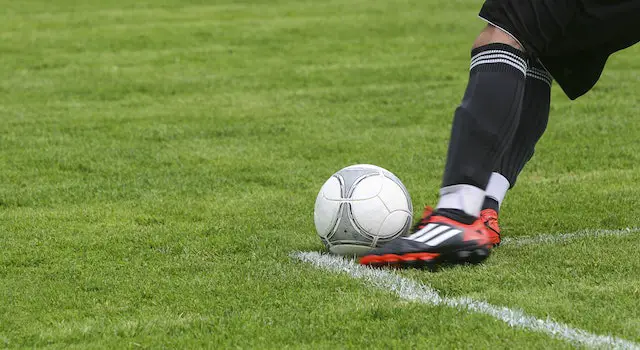How To Read Football Plays?
Football play calls can be confusing. This is especially true if you have never been in an NFL game.
To read football plays, you must understand your coach’s terminology. Once you do, memorizing and understanding plays will become much easier.
What is a read play in football?
In the general sense, a football game is a pre-planned action players take to advance the ball to the opponent’s goal line. There are many kinds of football games which are all designed to meet the same goal. Here are some typical types of football play:
Running Plays
Running plays are intended to make yards by handing over the ball to the running back. There are various kinds of running games, such as:
- Dive: The running back picks up the ball and sprints straight into the line of scrimmage seeking to get the most yards possible.
- Off-tackle: The running back grabs the ball , and then runs along the other side from the offensive line following a particular blocker in order to make yards.
- Sweep: The running back grabs the ball and sprints towards the outside, searching for a gap in the line of defense in order to make yards.
Passing Plays
The purpose of passing plays is to get yards from using the sky by throwing the ball at the receiver. There are various types of passing games, including:
- Slant: The player takes an uninvolved route to midfield trying to get the ball in his grasp and gain yards following the catch.
- In: A receiver follows in a direction towards the sideline and hopes to catch the ball and then get out of bounds, thereby stopping the clock.
- Hitch: The receiver takes on a narrow route, and then is stopped and hopes to catch the ball, and gain yards following the catch.
Trick Plays
Trick plays are devised to surprise defenses by performing something that is unanticipated. There are various kinds of trick plays such as:
- Flicker of the flea: A quarterback passes the ball an RB who returns it to the quarterback who throws the ball into the field.
- Reverse: The player passes the ball off to a teammate. The player moves in opposite direction and attempts to gain some yards.
- False punt: The punting team is set up in a manner as if they were planning to kick the ball, however instead, they execute an attack to try to gain yards.
Special Teams Plays
Special teams are games made to be used on punts, kickoffs, or field goals. There are many kinds of special teams games which include:
- The kickoff returns: The team that is receiving is able to catch the ball in the final zone, and is determined to get it back as long as is feasible.
- Punt return: The team receiving is the one who catches the ball after it is punted, and attempts to retrieve it as long as is feasible.
- Goal field: The player tries to kick the ball over the goalpost of the opponent to score three points.
Every football game is created to accomplish a particular goal and is carried out by the players of the team according to their position and play’s layout. Knowing the various types of football games can help you comprehend the game and enjoy it more.
Football Lines and Common Player Positions
Line Of Scrimmage
The line of scrimmage is a key marker on the field and is where most football plays begin. It is also where the quarterback gets to work when he throws a pass or runs.
A legal football formation requires seven players to line up on the line of scrimmage, including the center. The offensive linemen and tight ends usually make up the initial seven, but receivers can also be included in a legal formation.
There is a certain amount of leeway for the offensive team to move around before the snap, but this does not apply to the defensive side. The defense cannot cross over the scrimmage line until the offensive team has made a touchdown or a handoff.
However, if a defensive player crosses the scrimmage line before the ball is snapped, this is called an encroachment. It can be a frustrating rule to enforce, but it is a necessary safeguard.
Another way to read the line of scrimmage is to watch how linemen position themselves at the snap of the ball. If the offensive linemen all stand straight up at the snap, they will pass, advises Mark Oristano in “A Sportscaster’s Guide to Reading Football.”
Similarly, if the linemen blast forward across the line of scrimmage, it signals a running play. Follow visually the guards who flank the center if they do this, Oristano says.
This is one of the best ways to read the line of scrimmage and can tell you a lot about where a play is headed before it happens. And it can also give you some insight into how the lineman will be positioned later in the play.
You can also see how the linemen will move during a play by watching their positioning in the backfield. During a run play, for instance, you’ll often see the guards move toward the center while the tackles shove toward the line of scrimmage.
This can be an important indicator of where the lineman will be positioned in the backfield since it will show how far away they are from the quarterback. This is especially true on pass plays, where the quarterback needs to see where his running back is going before he throws the ball.
Alignment
If you’re new to football, one of the best ways to get started is by learning how to read the alignment. This will help you understand what each player is doing as they play the game.
The alignment is the position of each player on the field. This is important because it tells you how they will be positioned when they run or pass the ball.
Most football plays will include a description of the alignment. This can include the formation of each player, the front they are in, and a number that will tell you where they are to each other.
Another common feature of football plays is the shift. This is where the offensive line changes its alignment from one formation to another. This will allow the offense to move forward or backward on the field depending on what the quarterback calls out in his play call.
Some offensive lines will even change their spacing and depth to tip off the defense. These may seem insignificant initially, but it’s an important part of a good passing game.
For example, if you notice that a guard is in a 2-point stance and slightly further off the line of scrimmage than normal, this indicates that a pass play is coming.
Similarly, if you see that a running back is scanning the defense before the snap of the ball, this indicates that the play will involve a blitz. This is a tactic that linebackers and safeties use to try and stop the opposing team’s offense before it can attack.
When you learn how to read the alignment, you can make more informed decisions about what plays are worth watching during a game. This will help you determine what will be important to the rest of your team and help you win the game.
It’s difficult to read a football play, especially if you’re new to it. However, if you follow the advice in this article and practice, you can become an expert at reading a football play.
Point Of Attack
One of the most important parts of football is the point of attack. The point of attack is the area behind the line of scrimmage the ball carrier aims to run through. This space, called the hole or gap, is determined by the spacing between the offensive linemen before the snap.
Running plays are usually predetermined and communicated with numbers to the player carrying the ball (a quarterback, a tailback, or a fullback). These players then aim for the holes designated by the offensive linemen. The holes are typically numbered on the left and even on the right, with 0 being directly behind the center.
The most basic running play is a run up the middle. The back aims for a hole between his offensive linemen, usually between the center and guard or the guard and tackle. The blockers will then run block, pushing defenders away from the hole and making it easier for the running back to run through it.
Another common run play is a draw. This is a play where the quarterback takes a drop into pass-blocking positions and then hands the ball off to his running back or keeps it himself and runs forward past rushing defenders. This can result in the runner having a large gap between him and his opponent, and it also gives the offense a chance to use motion or ball fakes in their play.
A big advantage of this type of play is that it takes a strong defensive end out of the play. In addition, this play is an excellent way to confuse the defense as it takes them out of their normal assignment and makes them read differently.
This type of play is often used to get a number advantage before the snap, but it can also be used to set up a zone read. The zone read is a big play in football that can gash a defense if the O-Line can win at the point of attack and the QB makes the right read.
Blitz
In football, a blitz is a play that sends more players toward the quarterback quickly. This can be used to sack the quarterback or to force an incomplete pass. It’s an important part of the game and can be difficult to read.
A team behind in the game may use a blitz to change the defense’s momentum. They may want to sack the quarterback or force an interception to keep their lead in this situation.
A blitz is similar to a pass rush when a defense rushes the quarterback with five or more defensive players. The goal of a blitz is to put pressure on the quarterback and make him throw off his back foot.
However, a few differences exist between a blitz and a pass rush. The primary difference is that a blitz is a more threatening way to disrupt play. In addition, a blitz typically carries higher risks and lower rewards.
Another difference is that a blitz often leads to more sacks than a pass rush. A blitz usually involves more defenders, so they have more opportunities to get to the quarterback. Unfortunately, this also means more opportunities for a play to go wrong, leaving your defense vulnerable.
There are many different types of blitzes, and each can be effective in a particular game. For instance, a blitz can prevent a touchdown, recover an interception, or stop the running back at the line of scrimmage.
If you’re a coach, there are several things you can do to read your opponent’s blitzes. First, you should study your opponent’s tendencies. This will help you identify the best times to blitz them and how they like to respond to it.
A second option is to look at a specific play. For example, a team could run a read blitz to remove a play’s slant window. The blitzing linebacker drops into coverage at the snap and tries to block a quick throw.
Reading football plays can be a challenging task, especially for those who are new to the game. However, with some practice and understanding of the basics, understanding and interpreting the plays can become easier.
Tips On How To Read Football Plays:
Understand the field:
Before you can read football plays, it is important to understand the field well. Familiarize yourself with the various zones, such as the end zone, red zone, and midfield.
Know the players:
Each player on the field has a specific position and role. Understanding the roles of the quarterback, running back, wide receiver, tight end, offensive line, and defensive line can help you interpret the plays.
Look at the formation:
The offense’s formation can provide important clues about the play being run. The formation can indicate whether the play will be a pass or a run and which direction the ball will likely go.
Pay attention to motion:
Players in motion can provide additional clues about the play. For example, if a wide receiver is in motion, they may be setting up for a reverse or end-around play.
Watch for blocking:
Blocking is an important part of football plays and can provide clues about where the ball will likely go. For example, if the offensive line shifts to one side, it may indicate that the running back will run to that side.
Look at the defense:
The defense can also provide important clues about the play. For example, if the defense shows a blitz, the offense may prepare for a quick pass or a running play.
Watch the ball:
Finally, always keep an eye on the ball. The ball carrier’s movements can provide important clues about the play, such as whether they will pass or run.
In conclusion, reading football plays takes practice and patience. Still, it can become easier to understand and interpret the plays by understanding the basics of the game and paying attention to key clues such as formation, motion, blocking, and defense. Keep these tips in mind, and with time and practice, you’ll become an expert at reading football plays.
FAQ’s
How do you read a football formation?
How can football formations be read? The order of the defenders to the forwards is used to write and design football formations. The phrase “4-4-2” denotes four defenders, four midfielders, and two strikers. “4-5-1” would denote a formation with 4 defenders, 5 midfielders, 1 forward, etc.
What do the numbers mean in football plays?
Each ball carrier has a number, just like every hole does. One is the quarterback, two is the halfback, and three is the fullback. When calling running plays, the number of the back is called first, followed by the number of the hole and the type of run.
How do plays work in football?
A play in football is a tactic used by football coaches to move their team and either score a touchdown or prevent one from occuring, depending on whether their team is on offence or defence. Both teams pay attention to the coach’s instructions on which play to execute before the ball is snapped.





















